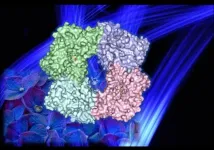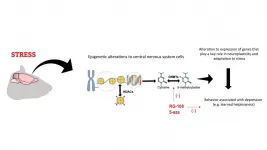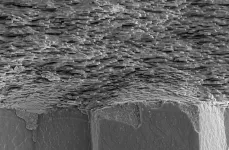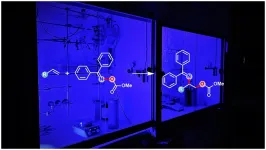New USC study on circadian clock shows "junk DNA" plays a key role in regulating rhythms
Study suggests the impact of non-coding microRNAs on circadian rhythms is tissue specific and may reveal new insights into disease processes
2021-01-04
(Press-News.org) If you've ever had a bad case of jet lag, you know how a disruption to your body's circadian rhythm makes it difficult to function. Molecular circadian "clocks" exist in cells throughout the body, governing more than just sleep and wake cycles - they are crucial to many aspects of human health. For more than a decade researchers have been trying to figure out what makes them tick, in search of new insights into diseases like Alzheimer's, cancer and diabetes.
Until now, that research has focused on what is known as clock genes, which encode proteins that drive oscillating cycles of gene expression affecting physiology and behavior. But research just published in the Proceedings of the National Academy of Sciences reveals the discovery of a new cog in the circadian clock - a genome-wide regulatory layer made up of small chains of non-coding nucleotides known as micro RNAS (miRNAs).
"We've seen how the function of these clock genes are really important in many different diseases," said Steve Kay, Provost Professor of neurology, biomedical engineering and quantitative computational biology at the Keck School of Medicine of USC. "But what we were blind to was a whole different funky kind of genes network that also is important for circadian regulation and this is the whole crazy world of what we call non-coding microRNA."
"Junk DNA" proves to be a valuable tool in circadian rhythms
Formerly thought to be "junk DNA," miRNAs are now known to affect gene expression by preventing messenger RNA from making proteins. Past research has indicated miRNAs may have a role in the function of circadian clocks but determining which of the hundreds of miRNAs in the genome might be involved remained a problem.
Kay and his team, led by Lili Zhou, a research associate in the Keck School's Department of Neurology, turned to the Genomics Institute of the Novartis Research Foundation (GNF) in San Diego which has created robots capable of high throughput experiments. Working with scientists at the institute, Zhou developed a high throughput screen for a robot to test the close to 1000 miRNAs by individually transferring them into cells the team had engineered to glow on and off, based on the cell's 24-hour circadian clock cycle.
"The collaboration with GNF made it possible for us to conduct the first cell-based, genome-wide screening approach to systematically identify which of the hundreds of miRNAs might be the ones modulating circadian rhythms," said Zhou.
"Much to our surprise," said Kay, "we discovered about 110 to 120 miRNAs that do this."
With the help of Caitlyn Miller, a biochemistry undergraduate from USC Dornsife, researchers then verified the impact on circadian rhythms by inactivating certain miRNAs identified by the screen in their line of glowing cells. Knocking out the miRNAs had the opposite effect on the cells' circadian rhythm as adding them to the cells.
Physiologic and behavioral impacts of miRNAs
Researchers also focused on the physiologic and behavioral impacts of miRNAs. They analyzed the behavior of mice with a particular cluster of miRNAs inactivated - miR 183/96/182 - and saw that inactivating the cluster interfered with their wheel-running behavior in the dark compared with control mice. They then examined the impact of the miRNA cluster on brain, retina and lung tissue, and found that inactivating the cluster affected circadian rhythms in a different way in each tissue type - suggesting that the way the miRNAs regulate the circadian clock is tissue specific.
Understanding the impact of miRNAs on the circadian clock in individual tissue could reveal new ways of treating or preventing specific diseases.
"In the brain we're interested in connecting the clock to diseases like Alzheimer's, in the lung we're interested in connecting the clock to diseases like asthma," said Kay. "The next step I think for us to model disease states in animals and in cells and look at how these microRNAs are functioning in those disease states."
INFORMATION:
About the study
The study's co-authors are Caitlyn Miller, Keck School of Medicine of USC, Loren J. Miraglia and Angelica Romero of the Genomics Institute of the Novartis Research Foundation, and Ludovic S. Mure and Satchidananda Panda of the Salk Institute for Biological Studies .
This work was supported by National Institute of Diabetes and Digestive and Kidney Diseases Grant 5R01DK108087 to S.A.K.
ELSE PRESS RELEASES FROM THIS DATE:
2021-01-04
Plants can perceive and react to light across a wide spectrum. New research from Prof. Nitzan Shabek's laboratory in the Department of Plant Biology, College of Biological Sciences shows how plants can respond to blue light in particular.
"Plants can see much better than we can," Shabek said.
Plants don't have dedicated light-detecting organs, like our eyes. They do have a variety of dedicated receptors that can sense almost every single wavelength. One such are the blue light photoreceptors called cryptochromes. When the cryptochrome detects an incoming photon, it reacts in a way that triggers a unique physiological response.
Cryptochromes probably appeared billions of years ago with the first living ...
2021-01-04
By Karina Ninni | Agência FAPESP – Treatment of depression faces two main challenges. The first is that almost 50% of patients do not respond well to existing antidepressants. The second is that conventional medications take a relatively long time – around three to five weeks – to have the desired effect. A group of researchers affiliated with the University of São Paulo (USP) in Brazil set out to tackle the second problem by using epigenetic modulators to try to “erase” the consequences of stress. Epigenetic mechanisms are part of a complex system that controls how and when genes are switched on or off.
Exposure to stress, a key trigger of depression, alters certain epigenetic markers in the brain. Many of these alterations ...
2021-01-04
The coronavirus pandemic is creating a large spike in significant psychological distress among Americans, with the first month of the pandemic causing as much distress in the same number of individuals that experienced it during the whole previous year, according to a new RAND Corporation study.
Findings from the first longitudinal study of psychological distress during the pandemic show that among a representative sample of Americans, more than 10% reported experiencing symptoms of significant psychological distress during April and May of 2020 -- the same amount they reported experiencing over an entire year during a survey conducted a year earlier.
The study also found that people with distress prior to the ...
2021-01-04
Scientists have long been aware of the dangerous overuse of antibiotics and the increasing number of antibiotic-resistant microbes that have resulted. While over-prescription of antibiotics for medicinal use has unsettling implications for human health, so too does the increasing presence of antibiotics in the natural environment. The latter may stem from the improper disposal of medicines, but also from the biotechnology field, which has depended on antibiotics as a selection device in the lab.
"In biotech, we have for a long time relied on antibiotic and chemical selections to kill cells that we don't want to grow," said UC Santa Barbara chemical engineer Michelle ...
2021-01-04
Following the repeal of the short-lived Cook County, Illinois Sweetened Beverage Tax, sales of sweetened beverages went right back to where they were before the tax went into place, according to a new study led by researchers at the University of Illinois Chicago. The study is published in JAMA Network Open.
The tax, which included both sugar-sweetened and artificially-sweetened diet beverages, was largely pitched as a way to reduce county budget deficits. The tax lasted just four months -- it went into effect on Aug. 2, 2017 and ended on Dec. 1, 2017.
"We ...
2021-01-04
Mollusks build shells to protect their soft tissues from predators. Nacre, also known as the mother of pearl, has an intricate, highly regular structure that makes it an incredibly strong material. Depending on the species, nacres can reach tens of centimeters in length. No matter the size, each nacre is built from materials deposited by a multitude of single cells at multiple different locations at the same time. How exactly this highly periodic and uniform structure emerges from the initial disorder was unknown until now.
Nacre formation starts uncoordinated ...
2021-01-04
Drones, robots and autonomous systems can transform the natural world in and around cities for people and wildlife.
International research, involving over 170 experts and led by the University of Leeds, assessed the opportunities and challenges that this cutting-edge technology could have for urban nature and green spaces.
The researchers highlighted opportunities to improve how we monitor nature, such as identifying emerging pests and ensuring plants are cared for, and helping people engage with and appreciate the natural world around them.
As robotics, autonomous vehicles and drones become more widely used across cities, pollution and traffic ...
2021-01-04
What The Study Did: In this observational study of 5,256 U.S. nursing home residents with COVID-19, increased age, male sex and impaired cognitive and physical function were independent risk factors for all-cause 30-day mortality.
Authors: Orestis A. Panagiotou, M.D., Ph.D., of the Brown University School of Public Health in Providence, Rhode Island, is the corresponding author.
To access the embargoed study: Visit our For The Media website at this link https://media.jamanetwork.com/
(doi:10.1001/jamainternmed.2020.7968)
Editor's Note: The article includes conflict of interest and funding/support disclosures. Please see the article for additional information, ...
2021-01-04
What The Study Did: The findings of a survey study using data from California suggests the COVID-19 pandemic was associated with increases in self-reported worry about violence for oneself and others, increased firearm acquisition and changes in firearm storage practices.
Authors: Nicole Kravitz-Wirtz, Ph.D., M.P.H., University of California Firearm Violence Research Center and Violence Prevention Research Program, Department of Emergency Medicine, University of California Davis School of Medicine in Sacramento, is the corresponding ...
2021-01-04
Whether in beta-blockers to treat high blood pressure or in natural products: So-called vicinal aminoalcohols are high-quality organic compounds that are found in many everyday products. However, their production is difficult. For a long time, chemists are trying to develop efficient methods of synthesizing them. In their recent study published in the journal Nature Catalysis, scientists led by Prof. Dr. Frank Glorius of Münster University have found a solution for the production of a special variant of aminoalcohols. "The new method helps to study the properties of the substance and to find applications for these ...
LAST 30 PRESS RELEASES:
[Press-News.org] New USC study on circadian clock shows "junk DNA" plays a key role in regulating rhythms
Study suggests the impact of non-coding microRNAs on circadian rhythms is tissue specific and may reveal new insights into disease processes




